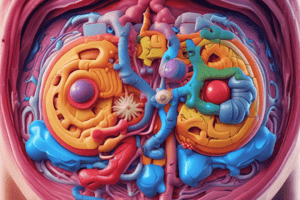Podcast
Questions and Answers
What is the origin of Oxytocin?
What is the origin of Oxytocin?
- Created in the kidney
- Synthesized in the posterior pituitary
- Produced in Paraventricular nuclei in the hypothalamus (correct)
- Derived from the adrenal glands
Which defect causes Nephrogenic Diabetes Insipidus?
Which defect causes Nephrogenic Diabetes Insipidus?
- Lesion of the hypothalamo-hypophyseal tract above the median eminence
- Autosomal mutation of V2 receptors gene in the kidney (correct)
- X-linked mutation of aquaporin2 gene
- Lesion in the supraoptic nucleus
Why do patients with Diabetes Insipidus experience polyuria?
Why do patients with Diabetes Insipidus experience polyuria?
- Increased blood glucose levels
- Excessive water loss with no increase in other constituents (correct)
- Decreased water intake
- Excessive sodium loss in urine
What mechanism of action does Oxytocin have?
What mechanism of action does Oxytocin have?
What causes Central Diabetes Insipidus?
What causes Central Diabetes Insipidus?
Why do patients with Diabetes Insipidus develop polydipsia?
Why do patients with Diabetes Insipidus develop polydipsia?
Which protein carries 2/3 of T4 and 1/2 of T3 in the blood?
Which protein carries 2/3 of T4 and 1/2 of T3 in the blood?
Why is T3 more active than T4?
Why is T3 more active than T4?
Which type of thyroid receptor does T3 specifically bind to?
Which type of thyroid receptor does T3 specifically bind to?
Where are extranuclear thyroid receptors found?
Where are extranuclear thyroid receptors found?
Which of the following is NOT a non-genomic action mediated by extranuclear receptors?
Which of the following is NOT a non-genomic action mediated by extranuclear receptors?
What is the primary physiological effect of Thyroid Hormones on metabolism?
What is the primary physiological effect of Thyroid Hormones on metabolism?
What effect do excessive thyroid hormones have on mitochondria?
What effect do excessive thyroid hormones have on mitochondria?
How do thyroid hormones affect Na/K ATPase enzyme activity in cell membranes?
How do thyroid hormones affect Na/K ATPase enzyme activity in cell membranes?
What effect do thyroid hormones have on protein metabolism?
What effect do thyroid hormones have on protein metabolism?
How do thyroid hormones affect fat metabolism?
How do thyroid hormones affect fat metabolism?
Which process is NOT affected by thyroid hormones?
Which process is NOT affected by thyroid hormones?
What is the consequence of increased activity of Na/K ATPase enzyme due to thyroid hormones?
What is the consequence of increased activity of Na/K ATPase enzyme due to thyroid hormones?
What stimulates the osteoblasts production of IL-6 and RANKL?
What stimulates the osteoblasts production of IL-6 and RANKL?
Which cells have no receptors for PTH?
Which cells have no receptors for PTH?
What does PTH do to phosphate reabsorption in the renal proximal convoluted tubules?
What does PTH do to phosphate reabsorption in the renal proximal convoluted tubules?
What is the role of 1,25(OH)2D3 (dihydroxycholecalciferol) in the kidneys?
What is the role of 1,25(OH)2D3 (dihydroxycholecalciferol) in the kidneys?
What effect does PTH and 1,25(OH)2D3 have on calcium reabsorption in the distal part of renal tubules?
What effect does PTH and 1,25(OH)2D3 have on calcium reabsorption in the distal part of renal tubules?
What effect do PTH and 1,25(OH)2D3 have on calcium and phosphate absorption by the intestine?
What effect do PTH and 1,25(OH)2D3 have on calcium and phosphate absorption by the intestine?
How is calcium primarily absorbed in the upper small intestine?
How is calcium primarily absorbed in the upper small intestine?
Which factor affects the solubility of calcium salts in the gastrointestinal tract?
Which factor affects the solubility of calcium salts in the gastrointestinal tract?
What is the role of vitamin D3 in calcium absorption?
What is the role of vitamin D3 in calcium absorption?
Which compound plays a crucial role in cell phosphorylation and dephosphorylation reactions?
Which compound plays a crucial role in cell phosphorylation and dephosphorylation reactions?
What happens when the concentration of cations and anions in a solution exceeds the solubility product?
What happens when the concentration of cations and anions in a solution exceeds the solubility product?




